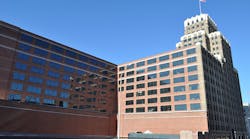Latest from Best Practices
Sponsored
Bracing HVAC equipment for seismic activity
Earlier this year, St. Louis-based Integrated Facility Services (www.intfs.com) began work on a $9,818,910 HVAC, plumbing and fire protection renovation project at the Robert A. Young Federal Building in downtown St. Louis. The project is part of a $62 million design-build seismic retrofit of the historic 20-story building led by design-build contractor McCarthy Building Cos. Inc. (www.mccarthy.com). Roughly 50 percent of the project is finished; completion is expected in March 2019.
The 1.05 million-sq.-ft. Young Federal Building is located within 150 miles of the New Madrid fault, one of the largest known earthquake faults in North America. IFS is relocating, replacing and bracing mechanical systems, VAV boxes, HVAC ductwork, fire protection and plumbing to accommodate the new structural steel braces and seismic dampers being installed to enhance safety during and after a potential seismic event. The mechanical contractor used Hilti anchors and seismic bracing systems from Vibration & Seismic Technologies.
“Seismic bracing load calculations and details all had to be worked out and designed ahead of time,” explains Gary Tidwell, IFS senior estimator and project manager of the Young job. “We worked closely with structural and mechanical engineers to comply with the bracing requirements specified for this job and area.
Classified as a Seismic Site Class D, Risk Category III, the bracing requirements for the Young building include:
• Stiffening the structure through the addition of concrete shear walls;
• Stiffening the structure through the addition of steel shear walls;
• Absorbing seismic energy and reducing lateral motion through the implementation of damping devices;
• Extension of new collector elements beyond the wall extents;
• Retrofit of columns due to large overturning forces for relatively narrow walls; and
• Excessive foundation work to resist large overturning forces.
“We spent many months in the building prior to any work actually starting, surveying each seismic brace location where shear walls and dampers were to be installed,” Tidwell notes. “By doing that, we knew pretty much ahead of time what to expect and what kind of work our crews were going to need to do.”
At IFS the company motto is “Start safe, stay safe.”
The brick and terracotta Young Federal Building, built in 1933 in the Art Deco style, is now owned and managed by the U.S. General Services Administration. In order to perform the seismic renovation work with a minimum of disruption to the nearly 40 federal agencies and more than 3,000 workers in the building, Tidwell notes that McCarthy and IFS are coordinating with the GSA to move the tenants to a swing space prior to the construction crews moving into the areas to work. In addition, barricades and dust protection are installed in work areas to insure tenant safety.
“Typically we will have three or four tinners and one or two plumbers in a work crew,” he says. “But that varies depending on magnitude of the particular area of work and what needs to be done. For this job, pipefitting work has been mainly in the basement and tower area.”
IFS got its start in 1966 by Bill Rundquist and Skip Sullivan as HVAC contractor Air Masters. Over the years, the company expanded services to include plumbing, fire protection, building automation and building security systems. In 2016, it rebranded as Integrated Facility Services Inc.; today it has annual billings of more than $50 million, employs 250 people and serves more than 4,000 clients in the St. Louis region, Missouri and Illinois. Its business breakdown is 50 percent HVAC, 22 percent HVAC service, 12 percent plumbing, 11 percent building automation and 5 percent fire protection.
Jobsite safety is a priority at IFS; the company motto is “Start safe, stay safe.” With a goal of a zero incident workplace, IFS believes no injury or lost workday is acceptable. To that end, a four-person team of safety professionals is tasked with developing, implementing and monitoring safety throughout the organization to maintain a safe, healthy and injury-free workplace. Every IFS employee is empowered to maintain a safe work environment by following strict safety protocols, reporting hazards and taking measures to prevent accidents.
The IFS Safety Program has earned industry recognition through safety awards from the National Fire Protection Association, the American Subcontractors Association, the Associated General Contractors, and the Sheet Metal and Air Conditioning Contractors’ National Association. It focuses on these four issues:
• Weekly safety training of all sales, shop, field and management personnel by OSHA 500 outreach trainers and consultants;
• Monthly IFS Safety Committee meetings with representatives from every department;
• Regular equipment, vehicle and tool maintenance; and
• Strictly enforced drug and alcohol policy.
Tidwell, a 42-year veteran in the mechanical trades (38 of them at IFS), notes that the company brings in representatives from Sheet Metal Workers’ Local 36 and the Plumbers and Pipefitters Local 562 to lead safety training classes for its crews. IFS project managers conduct jobsite safety audits when visiting work sites, when are sent to the IFS safety director. In addition, on the Robert A. Young Federal Building job, McCarthy required weekly safety meeting attendance of all subcontractors on site.
“Safety is always top priority and part of our everyday operation,” he says.


